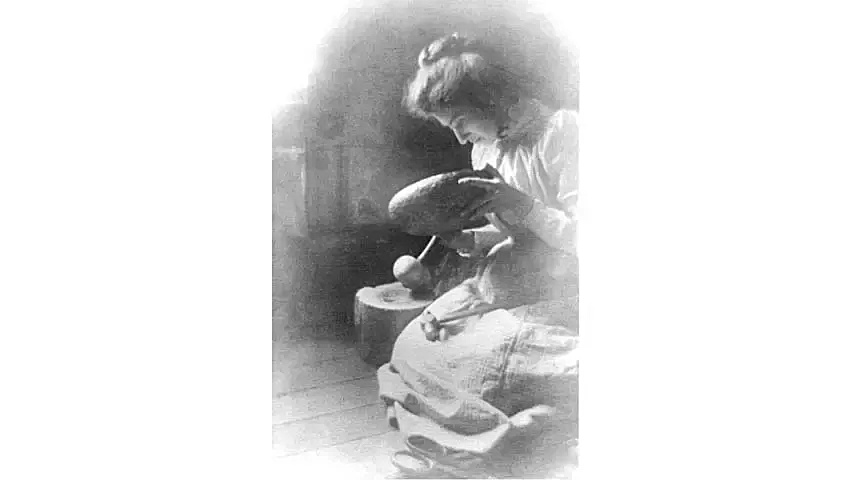Architect Mary Colter is renowned for her enduring and artistic buildings that showcase her brilliant and unique imagination, inspired by the history and culture of the Southwest.
Mary graduated from Saint Paul High School at the young age of 14, in 1883. Following her father’s unexpected passing three years later, she boldly convinced her mother to fund her art school education in order to support the family in the future.
She attended the California School of Design in San Francisco, where she immersed herself in a four-year program focused on art and design. During her time there, she also apprenticed in a local architect’s office and gained fundamental knowledge in the emerging field. At that time, certified architects were uncommon, with California only starting to license architects and establish professional standards in 1901.
In the early 1890s, Colter found herself teaching drawing and architecture in Wisconsin before returning to Saint Paul, where she dedicated 15 years to Mechanic Arts High School. Alongside her teaching responsibilities, she also lectured on architecture.

During a visit to a Fred Harvey shop in San Francisco, she became acquainted with the Fred Harvey Company. The company operated various establishments such as hotels, restaurants, lunch counters, shops, and dining cars for the Atchison, Topeka and Santa Fe Railway from 1876 onward.
In her desire to honor the region’s early inhabitants, Colter enlisted Hopi masons to construct the Hopi House. Completed in 1905, it provided lodging for Hopi artisans, exhibitors, and their families.

Colter held great admiration for the unique cultural heritage of the Southwest and actively explored the stunning corners of the Grand Canyon in search of Native ruins and artifacts. This fascination fueled the rustic and evocative nature of her architectural work.
Two of her notable creations, Lookout Studio (constructed in 1914 as a viewpoint for capturing the scenic landscape) and Hermits Rest (a stopping point for Harvey rail passengers), showcased her expertise and craftsmanship.

With the conclusion of World War I, Grand Canyon became an increasingly popular tourist destination. The number of visitors surged from approximately 44,000 in 1919 to 200,000 in 1929. Colter’s reputation grew further following President Woodrow Wilson’s designation of Grand Canyon as a national park in February 1919.
As a result, Colter received more commissions. One of her significant projects was Phantom Ranch, situated at the base of the canyon, which completed in 1922. Originally intended to be named after President Theodore Roosevelt, Colter preferred the more mysterious and alluring name of Phantom Ranch. The lodge’s design emphasized the use of harmonious local materials, such as native stone, and showcased Colter’s meticulous attention to organic details, resulting in a striking display of natural beauty.
A 70-foot-tall Watchtower, completed in 1932, represented another remarkable achievement for Colter. The tower drew heavy inspiration from the architectural style of the ancestral Puebloan people of the Colorado Plateau and was modeled after original structures discovered at Hovenweep and Mesa Verde.

One of Colter’s most ambitious endeavors was the development of Bright Angel Lodge. This extensive project, which cost approximately $500,000 (equivalent to $11.5 million today), included not only a small village of individual cabins but also a new lodge with various amenities. Colter prioritized the integration of materials salvaged from historical buildings of note, employing adobe and natural rock walls to create a visually stunning result. Bright Angel Lodge was completed in 1935.

Although some of Colter’s other hotels, such as El Ortiz in Lamy, New Mexico, were torn down, and El Navajo in Gallup, New Mexico, was dismantled and sold during her lifetime, several remarkable examples of her work still stand. The Painted Desert Inn and La Fonda, located in Santa Fe, are two such surviving structures. Notably, La Posada in Winslow, Arizona, which opened during the Great Depression in 1930, exemplifies Colter’s architectural and design vision. Considered by many to be her masterpiece, it served as one of the last great railroad hotels and attracted notable figures, including actors like Jimmy Stewart and James Cagney, during its early days.

Mary Elizabeth Jane Colter passed away at the age of 88 on January 8, 1958, and was laid to rest in Oakland Cemetery in Saint Paul. She bequeathed her extensive collection of Native pottery and unparalleled Indian, Spanish, and self-designed jewelry to Mesa Verde National Park in Colorado, where it is preserved and exhibited.
Discover more from Tension News
Subscribe to get the latest posts sent to your email.

